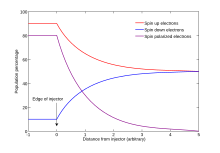It resembles an ordi- nary metal-oxide-semiconductor FET (MOSFET), but with a unique gate stack. The SOTFETgatestackcomprises three layers (from topto bottom): a spin–orbit (SO) layer, a ferromagnetic (FM) layer, and a multiferroic (MF) layer, adjacent toasemiconductor channel towhich sourceanddraincontactsaremade.
The conductivity of spin field-effect transistor (spin-FET) can be modulated by controlling the spin degree of freedom; therefore, emerging low-power applications can be explored. In this paper, we propose a novel device called multi-gate spin-FET where multi-gate voltages can successively modulate the spin of the electrons. Various logic functions can be implemented with multi-gate spin-FET. Manipulation of barriers’ geometrical symmetry and configuration leads to the conception of a spin-FET for non-volatile storage and digital logic operations. The linear modulation of electron spin polarization ( P ) is also studied for its relevance to electrical signal amplification.
Spintronics Review
Abstract
Boba Fett Spin Off
An analog of the Datta-Das spin field-effect transistor (FET) is investigated, which is all graphene and based on the valley degree of freedom of electrons/holes. The “valley FET” envisioned consists of a quantum wire of gapped graphene (channel) sandwiched between two armchair graphene nanoribbons (source and drain), with the following correspondence to the spin FET: valley (K and ) ↔ spin (up and down), armchair graphene nanoribbons ↔ ferromagnetic leads, graphene quantum wire ↔ semiconductor quantum wire, valley-orbit interaction ↔ Rashba spin-orbit interaction. The device works as follows. The source (drain) injects (detects) carriers in a specific valley polarization. A side gate electric field is applied to the channel and modulates the valley polarization of carriers due to the valley-orbit interaction, thus controlling the amount of current collected at the drain. The valley FET is characterized by (i) smooth interfaces between leads and the channel, (ii) strong valley-orbit interaction for electrical control of drain current, and (iii) vanishing interband valley-flip scattering. By its analogy to the spin FET, the valley FET provides a potential framework to develop low-power FETs for graphene-based nanoelectronics.
- Received 27 July 2012

DOI:https://doi.org/10.1103/PhysRevB.86.165411

©2012 American Physical Society

Abstract
An analog of the Datta-Das spin field-effect transistor (FET) is investigated, which is all graphene and based on the valley degree of freedom of electrons/holes. The “valley FET” envisioned consists of a quantum wire of gapped graphene (channel) sandwiched between two armchair graphene nanoribbons (source and drain), with the following correspondence to the spin FET: valley (K and ) ↔ spin (up and down), armchair graphene nanoribbons ↔ ferromagnetic leads, graphene quantum wire ↔ semiconductor quantum wire, valley-orbit interaction ↔ Rashba spin-orbit interaction. The device works as follows. The source (drain) injects (detects) carriers in a specific valley polarization. A side gate electric field is applied to the channel and modulates the valley polarization of carriers due to the valley-orbit interaction, thus controlling the amount of current collected at the drain. The valley FET is characterized by (i) smooth interfaces between leads and the channel, (ii) strong valley-orbit interaction for electrical control of drain current, and (iii) vanishing interband valley-flip scattering. By its analogy to the spin FET, the valley FET provides a potential framework to develop low-power FETs for graphene-based nanoelectronics.
- Received 27 July 2012
DOI:https://doi.org/10.1103/PhysRevB.86.165411
©2012 American Physical Society
